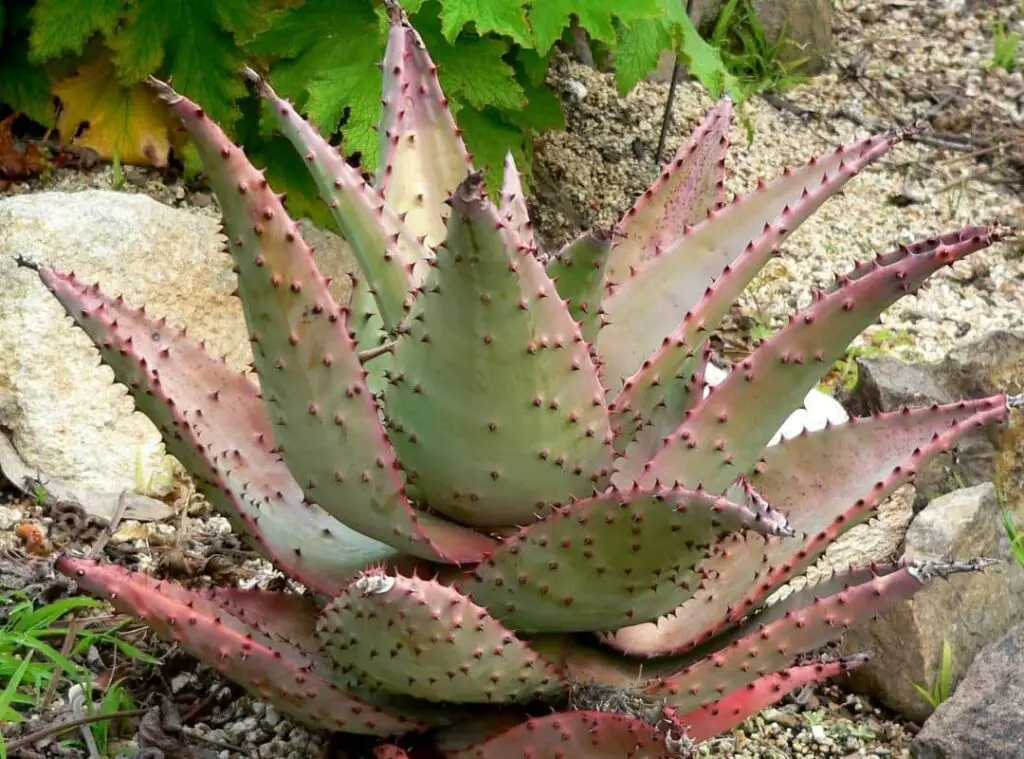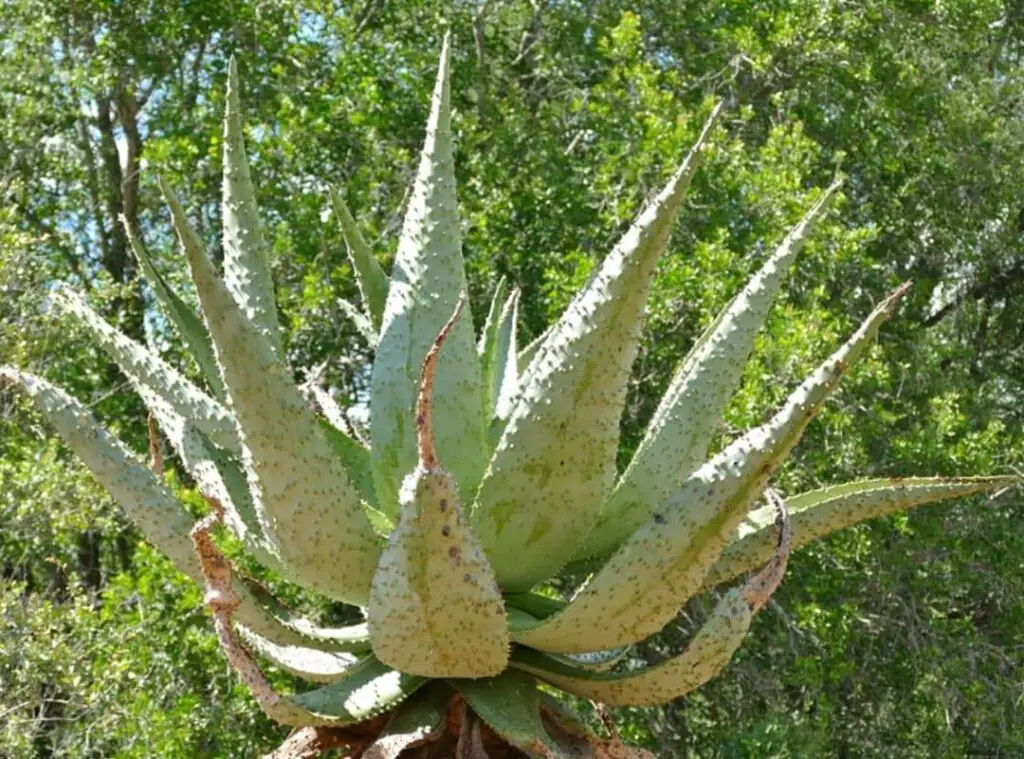Aloe marlothii is a wonderful flowering aloe species. Mountain aloe, spiny aloe, Transvaal aloe, and tree aloe are some other common names for these beauties. And They are endemic plants to South Africa. If you are an aloe plant lover, Aloe marlothii is a plant that you should never miss having in your garden.
These are known as frost-resistant plants too. Hence, if you are someone who lives in a colder area where you experience some frost, Aloe marlothii would be quite useful for you. Aloe marlothii are a slow-growing set of plants. However, it is not a concern at all since they would still look magnificent even if they are young.

Aloe marlothii contain spines. However, they would only add grace to the whole look of the plants. They can stand drought as well as weak frost too. Hence, they are a special set of plants. However, when you grow them as garden plants, it is vital that you grow them in a suitable growing medium and water them moderately, etc. Hence, you need to take the following point into account when you are growing the Aloe marlothii plants.
How do I identify Aloe marlothii?
Aloe marlothii plants have a robust appearance. Further, they produce bright flowers too. Aloe marlothii develops thick gray-green leaves. Further, Those leaves would form with a broad base to a sharp point. They would rise to about 5 feet in height along in a rosette which is densely structured. If you live in a humid area, you will see how the leaves may appear in a mode vibrant green color. On the other hand, Aloe marlothii old leaves may start to drape over from the stem and they will form a look of a skirt or petticoat.
That feature adds a robust appearance to the plant. Aloe marlothii further carry spines that are reddish brown in color.
They would form on the lower surfaces, and they would start off densely. However, they would become slender once they mature with age. You could spot the spines forming around the margins of each leaf. However, chances are that they would randomly form across the fleshy parts of the plants as well. Aloe marlothii had an unbranched stem and on top of that, you could find the rosette. The leaves would carry a sharp point.
The leaves would be 5 feet in length and up to 10 inches in width. The stem of the Aloe marlothii would reach a maximum height of 15 feet and withered leaves would be covering the stem. Besides all these, Aloe marlothii produce flowers in bright red and they would appear in late fall as well as in winter. They would form on a widespread branching panicle where it will have about 30 racemes.
Growth rate
Aloe marlothii are a slow growing set of plants. Ideally, they need to have 6 feet in width to have optimal growth. Having said that, You can grow them along with smaller plants in a complimentary garden.
One look care guide
| Botanical Name | Aloe marlothii |
| Common Name | Mountain aloe Spiny aloe Transvaal aloe Tree aloe |
| Plant Type | Cactus / succulent |
| Mature Size | maximum height of 8 feet – 10 feet maximum width of 5 feet – 6 feet |
| Sun Exposure | Full sunlight |
| Soil Type | Sandy, loamy |
| Soil pH | acidic / alkaline / neutral |
| Bloom Time | late fall to early winter |
| Flower Color | Red |
| Hardiness Zones | USDA hardiness zones 9a-11b |
| Native Area | South Africa |
| Toxicity | Toxic |
| Average price | 17 USD |
How do you take care of Aloe marlothii?
Light Requirement
When you grow them indoors, you need to grow them on a bright sunny windowsill where the plants can gain bright indirect sunlight. Further, expose them to light shade during the hottest parts of the day. Even if you grow them outdoors, you need to select a spot where they can gain full sunlight.
Temperature and humidity
Aloe marlothii can stand temperatures that are low as 20 degrees Fahrenheit – 50 degrees Fahrenheit ( -6.7 degrees to 10 degrees Celsius). Having said that, they are tolerant of extreme drought conditions also. Aloe marlothii are special plants since they can tolerate heat as well as light frost.
Is it cold hardy?
Aloe marlothii are somewhat cold hardy plants. They are tolerant of weak frost for some time
USDA Hardiness Zone
Aloe marlothii prefers to thrive in USDA hardiness zones 9a-11b.

Watering Requirement
You may consider watering them once a week during summer. As explained above, they can go waterless for several weeks as they are drought tolerant plants. Hence, they would be a perfect choice for people who don’t experience colder weather conditions. When it comes to watering them in winter, they can survive with light watering in these periods. If you end up over watering the plants in winter, it would only bring an unhealthy impact on the plants.
Literally, if you can spot them carrying inflated leaves, it would be a sign of overwatering. Ultimately it would result in rot if you do not treat them well.
On the other hand, if you spot any dull or too thin leaves that would also be a sign of underwatering. Aloe marlothii prefers to be in warmer wet summers and dry winters simply due to the fact that they are native to the monsoon season. Aloe marlothii are native to semi-arid areas of South Africa. As such ensure that you water them punctually despite where you locate them be it in the garden or in the pot.
Moreover, you need to water them when their soil is completely dry only. Further, when watering the pants, you need to water them thoroughly and ensure that the excess water is draining away from the draining holes.
Soil Requirement Type / pH
Aloe marlothii are tolerant of soil mixes in a wide array. They can thrive in sandy, loam soil mix or even in the acidic alkaline soil mix. Besides, they can also perform well in soil mix which has a neutral ph. level as well. If there is clay in excess in the soil mix it would lead to overwatering as it will be too dense for them to handle. One part of compost, one part of river sand to two parts of heavy clay soil would be a perfect soil mix for the Aloe marlothii if you particularly live in a damp region.
If you live in an arid environment, you can use undiluted soil as it will retain moisture for extended periods.
Moreover, you may consider adding bone meal as they would reduce the potential of having root rot. Aloe marlothii requires well-drained soil, composed of one-third of sand or pebbles, to prevent roots from rotting. Also, leaf rotting can occur, if you wet too much the leaves while watering and your water too frequently. If you grow them outdoors, ensure that you grow them in a sandy soil mix that is light. Alternatively, you can make a hold which has a width of half a meter and fill it with pumice, and quartz sand.
Pot size Potting and Repotting
Aloe marlothii are slow-growing plants. Hence, you do not have to repot the plants often. Having said that, if you had freshly purchased them from the garden stores, you need to consider repotting them. You may practice the general succulent and cactus repotting practices to repot them. Moreover, you need to go ahead with a porous material pot that has at least one draining hole in the bottom that would be ideal for the optimal growth of the Aloe marlothii plants.
Where to Plant
A strong sunlight level is critical for the optimal growth of the Aloe marlothii plants. Hence if you plant them in the garden, ensure they can gain sufficient sunlight. They would always prefer to have a warmer climate. Hence if you are expecting adverse colder weather conditions for extended periods, you need to bring them indoors. Further, ensure that you choose porous pots.
Fertilizer and time of year
Aloe marlothii do not require fertilizers regularly. However, you may consider feeding them when they are actively growing as it will provide extra nutrients for their growth.
Flower
Aloe marlothii produce flowers in bright red. Their flowering season would be late fall to early winter. They contain about 30 racemes which would usually grow horizontally. Aloe marlothii flowers have an inflorescence. Further chances are that they may form in orange yellow too. They are attractive to songbirds and for hummingbirds as well.
Dormancy
Aloe marlothii will be dormant in winter. During their dormancy, you need to skip feeding them and watering them.
Toxicity
As well as other Aloe plants, Aloe marlothii is toxic for people as well as for pets.
Common bugs and illnesses
Aloe marlothii are resilient plants. Hence, they can contend strongly against the attacks from pests and most other diseases as well. However, if you overwater them, it would lead to rot. Additionally, pests such as scale insects, mealybugs, mites’ snout beetles, and rust fungus could invade them on and off particularly if there is a favorable condition for them.

How to propagate Aloe marlothii
When Aloe marlothii grow in the wild, they propagate through the wind. Hence, when you grow them in your garden, they can easily spread through the wind. Besides, you can use the Aloe marlothii seeds and propagate them in a container that has a draining hole in the bottom. Next, you can place some stones at the bottom of the container. Next, add some compost and then add a sterile soil layer afterward.
If not, you may sow seeds in river sand and cover them with a sand layer. Next, do a light misting and place them in a spot where they can gain direct sunlight. Water them morning to afternoon and reduce watering them once they complete germination. You can transfer the seedling into a new pot. You need to ensure that you add a soil mix which is explained above. You need to conduct the seeds propagation method in spring to summer.
Aloe marlothii benefits
Many people tend to use the Aloe marlothii in sunscreens. They would protect your skin from UV rays and hence why people use them in sunscreens. They would be perfect additions for Mediterranean, cottage, and rock gardens. Moreover, Zulu people have used them to treat roundworms. Further, it has been used to treat stomach issues as well. Further medical experts have used the Aloe marlothii for some medical studies too.
Conclusion
Before wrapping this up, trust this article gives you a broader view of how you should look after the Aloe marlothii, the modes of propagating them, the diseases, and the attacks of the pests they may come across.
Read Next : Aloe Guido | 15 Super Important Care Facts About This Cute Plant | Aloe Crosby’s Prolific | 14 Care Facts You Would Love | Aloe Blizzard Succulent Care | 14 Not So Bizarre Facts |
